
The peony or paeony is a flowering plant in the genus Paeonia, the only genus in the family Paeoniaceae. Peonies are native to Asia, Europe and Western North America. Scientists differ on the number of species that can be distinguished, ranging from 25 to 40, although the current consensus is 33 known species. The relationships between the species need to be further clarified.

Paeonia rockii, or Rock's peony, is a woody species of tree peony that was named after Joseph Rock. It is one of several species given the vernacular name tree peony, and is native to the mountains of Gansu and adjoining provinces in China. In Chinese, it is known as 紫斑牡丹.

Lavandula angustifolia, formerly L. officinalis, is a flowering plant in the family Lamiaceae, native to the Mediterranean. Its common names include lavender, true lavender or English lavender ; also garden lavender, common lavender, and narrow-leaved lavender.

Paeonia lactiflora is a species of herbaceous perennial flowering plant in the family Paeoniaceae, native to central and eastern Asia from eastern Tibet across northern China to eastern Siberia.

Dicentra formosa is a flowering plant with fern-like leaves and an inflorescence of drooping pink, purple, yellow or cream flowers native to the Pacific Coast of North America.

Paeonia daurica subsp. mlokosewitschii, the golden peony or Caucasian peony, is a species of flowering plant native to the Caucasus Mountains in Azerbaijan, Georgia, and Dagestan, where it grows on rocky slopes in oak, hornbeam, or beech forests. The plant is sometimes nicknamed Molly the witch, a humorous mispronunciation of the species name, which most people find difficult to pronounce. It was formerly regarded as a separate species, Paeonia mlokosewitschii, but in 2002, the Chinese botanist Hong Deyuan reduced it to a subspecies of Paeonia daurica.

Malva thuringiaca, the garden tree-mallow, is a species of flowering plant in the mallow family Malvaceae, native to eastern Europe and southwestern Asia, from southern Germany south to Italy, and east to southern Russia, Kazakhstan, and Turkey.
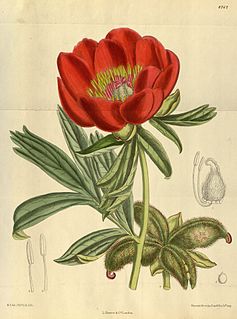
Paeonia peregrina is a species of flowering plant in the peony family Paeoniaceae, native to Southeastern Europe and Turkey. It is an erect, herbaceous perennial with 9-lobed, deeply divided leaves. Single, glossy red flowers, 10–13 cm (4–5 in) in diameter, with prominent yellow stamens, are borne in spring.
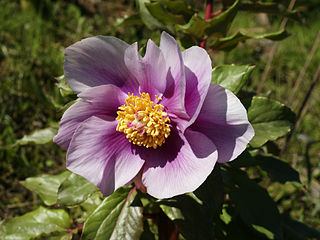
Paeonia mascula is a species of peony. It is a herbaceous perennial 0.5–1.5 m (1.6–4.9 ft) tall, with leaves that are divided into three segments, and large red flowers in late spring and early summer. Native to Syria, Spain, France, Italy, Croatia, Bosnia and Herzegovina, Serbia, Montenegro, Bulgaria Greece, Turkey, Iraq, Lebanon and Israel, this wild peony has become naturalised on two small islands in the UK.
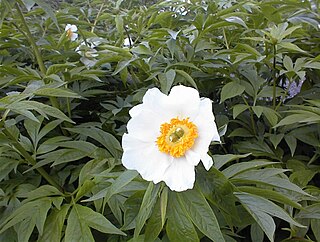
Paeonia emodi is a robust herbaceous perennial plant that winters with buds underground, has large white flowers and large deeply incised leaves, and belongs to the family Paeoniaceae. Its local vernacular names include mamekhor or mamekh (Punjabi), ood-e-saleeb (Urdu) meaning "with-a-cross", ood salap (Hindi), mid and 多花芍药 meaning "multi-flower peony". In English it is sometimes called Himalayan peony. It is among the tallest of the herbaceous peony species, and, while cold-hardy, it grows better in warm temperate climates. It is a parent of the popular hybrid 'White Innocence', which reaches 1½ m.
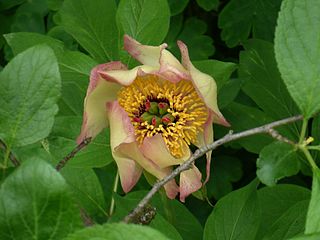
Paeonia daurica subsp. wittmanniana, also known as Wittmann's peony, is a perennial peony native to the southern Transcaucasian region. It was formerly regarded as a separate species, Paeonia wittmanniana, but in 2002, the Chinese botanist Hong Deyuan reduced it to a subspecies of Paeonia daurica. It is closely related to another subspecies of P. daurica, P. daurica subsp. mlokosewitschii.

Paeonia × suffruticosa is a name used for a group of cultivars of tree peonies that are the result of hybridisation with species exclusively belonging to the subsection Vaginatae. The common name used in China is mǔdān. Plants belonging to this group have been cultivated for millennia in China, initially only as a source of traditional Chinese medicine particularly the skin of its roots. Already early on the plant was also cultivated for its ornamental value, and it is highly revered in Chinese culture.
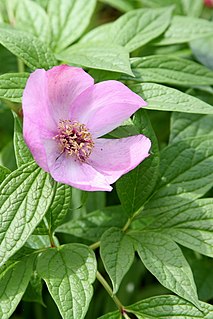
Paeonia mairei is a species of peony, that is endemic to the mountains of central China. Its vernacular name in China is 美丽芍药 meaning "beautiful peony". The plant may be between 45–100 cm high and has mostly rose-pink flowers of about 10 cm across, one on each stem. P. mairei blooms in early spring.

Paeonia tenuifolia is a herbaceous species of peony that is sometimes called the fern leaf peony. It is native to the Caucasus Mountains of Russia and the Black Sea coast of Ukraine, spreading westward into Bulgaria, Romania and Serbia and eastward to northwestern Kazakhstan. It was described by Linnaeus in 1759. The leaves are finely divided into almost thread-like segments and grow close together on the stems. This peony can reach 30–60 cm (12–24 in) in height. The scented red flowers have numerous yellow stamens in the centre.
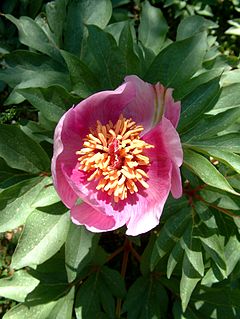
Paeonia clusii is a relatively low (25–50 cm) species of herbaceous peony with scented, white or pink flowers of up to 12 cm in diameter. In the wild, the species can only be found on the islands of Crete and Karpathos, and Rhodes. It has pinkish-purple stem up to 30 cm long and glaucous dissected leaves. P. clusii blooms in mid-spring.
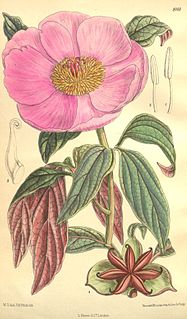
Paeonia cambessedesii is a perennial herbaceous species of peony about 45 cm high. It has pink flowers. The stems, major veins and undersides of the leaves remain purple red, while the upper surface of the leaves turns into a metallic bluish green when fully grown and its lower leaves consist of no more than nine leaflets or segments. This endemic of the Balearic Islands is now limited to parts of northeastern and northwestern Majorca. In English it is sometimes called Balearic peony or Majorcan peony.
Paeonia parnassica, the Greek peony, is a plant that is native to the mountains of south-central Greece. The flowers are produced in late spring with a deep maroon red colouring on 65 cm stems. The blooms are large, up to 12 cm in diameter and bear a boss of rich orange stamens. This peony was once included with the species P. mascula.
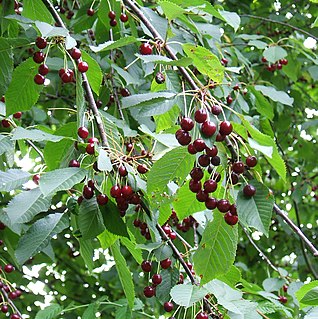
Prunus avium, commonly called wild cherry, sweet cherry, gean, or bird cherry is a species of cherry, a flowering plant in the rose family, Rosaceae. It is native to Europe, Anatolia, Maghreb, and Western Asia, from the British Isles south to Morocco and Tunisia, north to the Trondheimsfjord region in Norway and east to the Caucasus and northern Iran, with a small isolated population in the western Himalaya. The species is widely cultivated in other regions and has become naturalized in North America and Australia.

Astrantia major, the great masterwort, is a species of flowering plant in the family Apiaceae, native to central and eastern Europe. Growing to 90 cm (35 in) tall by 45 cm (18 in) broad, it is an herbaceous perennial, much used in gardens.
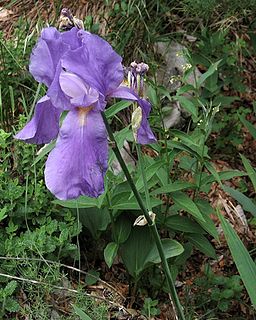
Iris pallida subsp. cengialti is a subspecies in the genus Iris, it is also in the subgenus Iris. It is a rhizomatous perennial, from Italy and Slovenia. It has yellowish-green, glaucous, lanceolate or ensiform leaves, tall stem, green flushed with purple spathes, 2 short branches, 2–3 scented flowers, in shades of violet, blue-violet, deep purple, blue-purple, deep blue-purple, pale purple, deep blue, to mid-blue. It has a yellow or orange tipped beard. It was originally published as Iris cengialti but then re-classified as a subspecies of Iris pallida, and known as Iris pallida subsp. cengialti, but it is often still called Iris cengialti. It is cultivated as an ornamental garden plant in temperate regions.




















